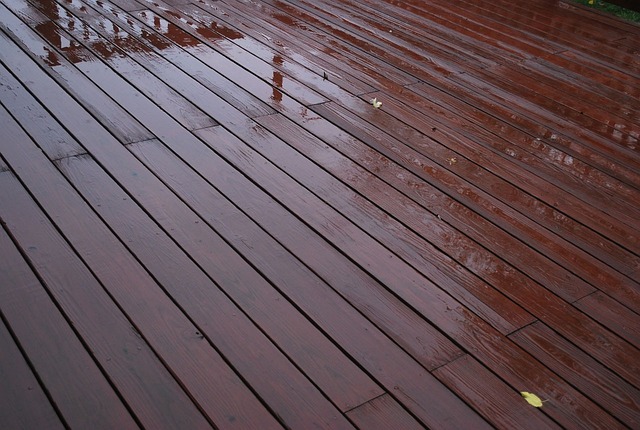Commercial Feature
How to Choose the Right Material for Your Weather-Resistant Deck Cover

When it comes to building a deck or any outdoor structure, the choice of materials isn’t just about aesthetics. We all want pretty structures styled in a way that matches our personal taste and adheres well to the overall setting, but we must not neglect durability and resistance to the elements.
Wood is often the most commonly used building material when it comes to decking, but if left untreated and exposed, it’s not the most durable material out there. In fact, when wet, wood is not even the safest material, as the development of a thin, imperceptible layer of moss forms during the rainy days of the fall.
The same applies to deck covers; choosing the right material is crucial to ensure the longevity of your deck, as well as its safety and use under various weather conditions. However, with a wide number of options available on the market, choosing the right material can be overwhelming, as many of these have their unique properties and benefits.
Understanding Water Resistance
Water resistance is a characteristic of certain materials, either natural or synthetic, that allows them to withstand exposure to the elements without degrading or inducing any changes in their structural integrity, at least in a short amount of time.
These materials are essential for deck covers, as they protect the deck from exposure to elements, including but not limited to rain, sunlight, wind, and temperature, as well as the combination of these elements and their fluctuations.
This not only ensures the durability and longevity of your deck but also plays a crucial role in the maintenance of your structure. By shielding other, less resistant materials, weather-resistant deck covers will minimize the maintenance costs of owning a deck.
Besides shielding the deck itself, weather-resistant deck covers also shield homeowners during their use of the outdoor space. While the covers themselves might not be the most adequate shielding from low temperatures, they excel at providing shelter against rain or sunlight.
Material Options
There are several materials that are commonly used for deck covers, and each has its own advantages and drawbacks. Wood is a classic choice due to its beauty and strength, but it offers the least in terms of weather resistance. Some types of wood, such as Cedar or Redwood, are naturally resistant to moss and moisture, as they contain plenty of oils and tannins.
Teak is also known for its durability and natural resistance to moisture, which is why it’s often used for outdoor furniture and decks in wetter climates. However, these could still benefit from maintenance to keep the moss and subsequent decay at bay.
Pressure-treated wood, on the other hand, is chemically treated to resist decay, insects, and moisture, but it’s not really immune to decay and moss growth; it’s only much more resistant. In either case, wood covers should be inspected annually, with a water-repellent sealer application every one to three years, depending on the exposure to the elements.
Aluminum is lightweight and durable and doesn’t require much maintenance. However, the material itself, as well as installation, might be pricey, so it’s worth considering whether the benefits outweigh the costs.
Vinyl is another cost-effective solution that’s relatively easy to install and maintain. While it offers fantastic resistance to moisture and works well with wood, it might not be as aesthetically appealing as natural materials.
Lastly, composite material combines wood fibers and plastic or some other materials, thus offering a balance of durability and aesthetics with less maintenance than wood. The biggest price indicator here is the color and durability aspect, as some composite materials are pricier than others.
Environmental Considerations
It’s really important to consider the local climate and geographic location when choosing adequate materials. For example, areas with plenty of sunlight imply high UV exposure, so you’ll want to choose materials that resist sunlight damage.
Humid and wet environments require the use of moisture-proof options to prevent mold and rot caused by the humidity. Temperature fluctuations also affect material performance, so choosing materials that don’t expand and contract much with temperature changes is really important.
Cost
The cost of materials, installation, and maintenance is an important factor when choosing the material for your deck cover. For example, the price of wood varies greatly depending on the type, while aluminum and composites often tend to be more expensive.
Vinyl is typically the most affordable option. There are also additional considerations, like whether or not you plan to DIY the project or higher professional help. This can also depend on the material used, as some materials require professional installation to ensure proper performance and durability.
Endnote
Ultimately, it’s important to consider the balance between durability, aesthetics, maintenance, environment, and associated costs when choosing weather-resistant materials for your deck cover. If you’d like to learn more or have any additional inquiries, don’t hesitate to contact https://surespancovers.com/.
 News / Cambridge launches plan to bridge ‘town and gown’ divide27 October 2025
News / Cambridge launches plan to bridge ‘town and gown’ divide27 October 2025 News / Government announces £400m investment package for Cambridge25 October 2025
News / Government announces £400m investment package for Cambridge25 October 2025 News / Cambridge don appointed Reform adviser23 October 2025
News / Cambridge don appointed Reform adviser23 October 2025 News / SU announces vote on NUS affiliation17 October 2025
News / SU announces vote on NUS affiliation17 October 2025 News / Climate and pro-Palestine activists protest at engineering careers fair25 October 2025
News / Climate and pro-Palestine activists protest at engineering careers fair25 October 2025




